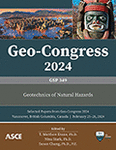Continuum-Based Modeling of Earthquake Fault Rupture Propagation through Layered Soils
Publication: Geo-Congress 2024
ABSTRACT
The occurrence of earthquake surface fault rupture poses a significant hazard to the built environment in near-fault regions. Despite the prevalence of heterogeneous soils, current models of this hazard mostly treat soil to be a homogeneous medium. This research investigates the influence of soil heterogeneity on earthquake surface fault rupture using the explicit finite difference method (FDM). The study aims to bridge the gap in modeling the influence of soil heterogeneity on earthquake surface fault rupture by comparing the results of finite difference models with those obtained from virtual experiments using the discrete element method (DEM). Continuum numerical models using the FDM in the FLAC2D software are implemented based on a previous study that utilized the DEM to simulate fault rupture propagation through layered soils without direct input of common constitutive properties. The finite difference models extend the use of the linear elastic perfectly plastic Mohr Coulomb model and the PM4Sand constitutive model to account for contrasts in soil properties and how they influence fault rupture propagation. Results show that, overall, PM4Sand models performed better than the MC models when compared to the DEM output results. In reverse faulting, the pattern of broadening within loose layers and re-localization within dense layers is observed with both constitutive models independently if the layer is overlaid by either a dense or loose layer. Similarly, simulations of normal faulting in layered soils revealed similar trends in the direction of fault rupture propagation. However, deviations from the DEM results were greater with the MC models. This study highlights the importance of implementing remeshing and a more rigorous calibration of parameters used in the PM4Sand constitutive model. Finally, this study assesses the capability of traditional continuum methods to capture complex soil behavior during normal and reverse faulting in heterogeneous materials.
Get full access to this article
View all available purchase options and get full access to this chapter.
REFERENCES
Abbasi, B., Russell, D., and Taghavi, R. (2013). “FLAC3D mesh and zone quality,” Continuum and Distinct Element Numerical Modeling in Geomechanics, Zhu, Detournay, Hart, and Nelson (eds.), Paper: 11-02, Itasca International Inc., Minneapolis, 12 pages, ISBN 978-0-9767577-3-3.
Boulanger, R. W., and Ziotopoulou, K. (2022). “PM4Sand (Version 3.2): a sand plasticity model for earthquake engineering applications.”, Center for Geotechnical Modeling, University of California, Davis, CA, March, 112 pp.
Bransby, M. F., Davies, M. C. R., El Nahas, A., and Nagaoka, S. (2008). Centrifuge modelling of reverse fault–foundation interaction. Bulletin of Earthquake Engineering, 6(4), 607–628.
Cole, D. A., and Lade, P. V. (1984). Influence zones in alluvium over dip-slip faults. Journal of Geotechnical Engineering. 110(5):599–615. https://doi.org/10.1061/(ASCE)0733-9410(1984) 110:5(599).
Garcia, F. E., and Bray, J. D. (2018). Distinct element simulations of shear rupture in dilatant granular media. International Journal of Geomechanics, 18(9), 04018111.
Garcia, F. E., and Bray, J. D. (2019). Discrete element analysis of earthquake fault rupture-soil-foundation interaction. Journal of Geotech Geoenviron Eng, 145(9), 04019046.
Garcia, F. E., and Bray, J. D. (2022). Discrete element analysis of earthquake surface fault rupture through layered media, Soil Dynamics and Earthquake Engineering, Volume 152, 2022, 107021, ISSN 0267-7261, https://doi.org/10.1016/j.soildyn.2021.107021.
Itasca Consulting Group, Inc. (2019). FLAC — Fast Lagrangian Analysis of Continua, Ver. 8.1. Minneapolis: Itasca.
Loukidis, D., Bouckovalas, G. D., and Papadimitriou, A. G. (2009). Analysis of fault rupture propagation through uniform soil cover, Soil Dynamics and Earthquake Engineering. 29, 1389–1404.
Mujtaba, H., Farooq, K., Sivakugan, N., and Das, B. (2017). “Evaluation of relative density and friction angle based on SPT-N values.” KSCE Journal of Civil Engineering, 22, 572–581. https://doi.org/10.1007/s12205-017-1899-5
Mortazavi Zanjani, M., and Soroush A. Numerical modelling of fault rupture propagation through layered sands. European Journal of Environmental and Civil Engineering. 23(9):1139–55. https://doi.org/10.1080/19648189.2017.1344148.
Oettle, N. K. (2013). Earthquake surface fault rupture interaction with building foundations. Doctoral Thesis. University of California, Berkeley.
Oettle, N. K., and Bray, J. D. (2016). Numerical procedures for simulating earthquake fault rupture propagation. International Journal of Geomechanics,17(1):04016025. https://doi.org/10.1061/ (ASCE)GM.1943-5622.0000661.
Information & Authors
Information
Published In
History
Published online: Feb 22, 2024
ASCE Technical Topics:
- Chemical properties
- Chemistry
- Constitutive relations
- Discrete element method
- Earthquake engineering
- Earthquakes
- Engineering fundamentals
- Environmental engineering
- Geohazards
- Geomechanics
- Geotechnical engineering
- Heterogeneity
- Layered soils
- Mathematics
- Methodology (by type)
- Numerical methods
- Pollution
- Soil mechanics
- Soil pollution
- Soil properties
- Soil treatment
- Soils (by type)
- Surface fault rupture
Authors
Metrics & Citations
Metrics
Citations
Download citation
If you have the appropriate software installed, you can download article citation data to the citation manager of your choice. Simply select your manager software from the list below and click Download.
